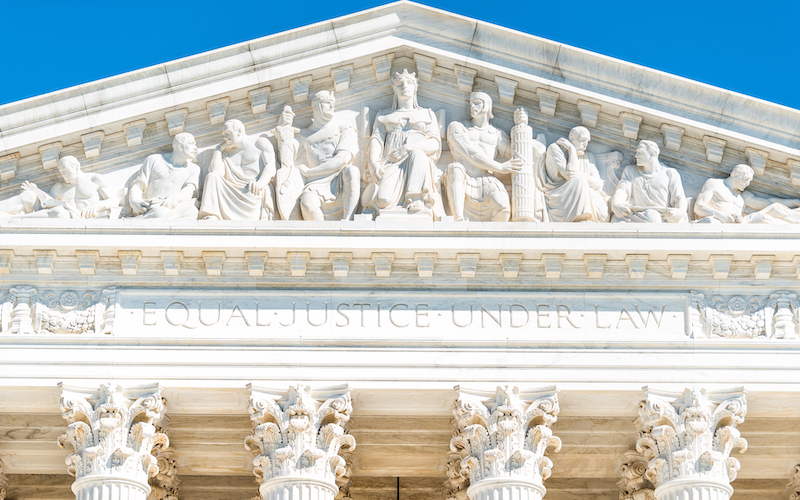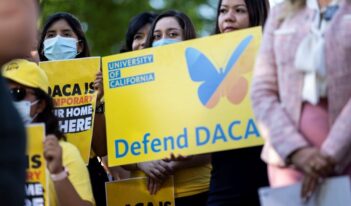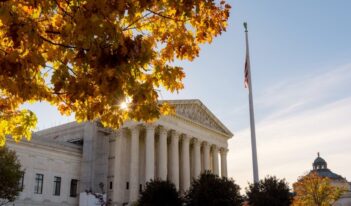
A recent Supreme Court decision maintains protection for people who arrived to the United States as children.
In a recent opinion authored by Chief Justice John Roberts, the U.S. Supreme Court rejected the Trump Administration’s attempt to end the Deferred Action for Childhood Arrivals (DACA) program.
DACA launched in 2012 when the U.S. Department of Homeland Security (DHS) issued a memorandum providing limited but substantial legal protection to Dreamers—immigrants brought to the United States as children. Although the program does not provide a pathway to citizenship, DACA grants Dreamers “deferred action,” a status that shields immigrants from deportation and allows recipients to obtain work authorization and other benefits. The protection lasts two years, after which DACA recipients can seek renewal.
But not all Dreamers receive DACA status. To qualify for DACA, Dreamers must submit an application and meet several stringent criteria, which include attending or completing high school or an equivalent or serving in the military, and having a near-spotless criminal record. Since its inception, DACA has protected over 800,000 Dreamers, although in 2017, it was estimated that over 1.3 million people were eligible.
Although DACA has enjoyed consistent, overwhelming support across the political spectrum, DHS rescinded the program in September 2017, announcing that new applications would be rejected and renewal requests would be phased out. Only days later, multiple plaintiffs challenged the rescission, and after winding its way through the federal court system, the Supreme Court concluded that the way the Trump Administration tried to rescind DACA was illegal.
The Court’s decision will have enormous practical consequences for current and prospective DACA recipients and for immigration policy more broadly—but the case itself focuses on several discrete administrative law issues.
First, the Chief Justice addressed the question of reviewability. Government lawyers had argued that courts could not review DACA’s rescission since DACA is considered a policy of non-enforcement—that is, it just announces that DHS will refrain from taking action against Dreamers. Under a legal doctrine established by the Supreme Court in 1985 in Heckler v. Chaney, courts cannot review agency inaction.
But in the DACA decision, the Court rejected the government’s claim that DHS’s policy was not reviewable. The Court held that “DACA is not simply a non-enforcement policy.” Rather, the DACA program creates opportunities for affirmative immigration relief through individual adjudications. Individuals apply for deferred action, and DHS decides whether to grant or deny their applications. By establishing this program, DHS took agency action, and that action is reviewable. The Court concluded that Heckler v. Chaney does not bar judicial review of DHS’s policy or its attempt to rescind that policy.
Second, the Court confronted the two DHS memoranda purporting to justify the agency’s rescission decision—an initial 2017 memorandum issued by then-Acting Secretary Elaine Duke terminating DACA and a follow-up 2018 memorandum issued by then-Secretary Kirstjen Nielsen, which “declined to disturb the Duke memorandum’s rescission of the DACA policy” and listed “several separate and independently sufficient reasons” for terminating DACA.
The Duke memorandum asserted that DACA was illegal because the policy allowed the Secretary of Homeland Security to grant eligibility for benefits on a classwide basis. In offering this justification, Acting Secretary Duke cited a decision by the U.S. Court of Appeals for the Fifth Circuit, which upheld an injunction stopping a similar DHS program from going into effect because it was inconsistent with the Immigration and Nationality Act. Citing a letter from then-Attorney General Jeff Sessions, the Duke memorandum also asserted that DACA “has the same legal and constitutional defects” that the Fifth Circuit recognized in the other DHS program.
But in the DACA decision, the Supreme Court refused to accept the 2018 memorandum as a basis for DHS’s attempted rescission. The Court cited its 2015 decision in Michigan v. EPA, in which it held that “a court may uphold agency action only on the grounds that the agency invoked when it took the action.” When deciding whether agency action is lawful, courts are therefore prohibited from considering after-the-fact justifications for agencies’ decisions.
As a result, the Court held that the Nielsen memorandum did not constitute an entirely new rescission order, nor was it a sufficient statement of the reasons for rescission that existed when the Duke memorandum was released. Rather, the Nielsen memorandum offered new and independent reasons for terminating the program. As those reasons were absent from the original rescission memorandum, the Court could not consider them. The Court emphasized that a prohibition on post hoc rationalizations for administrative decisions helps to ensure that government agencies take proper action the first time around, rather than cutting corners.
Third, the Court considered whether, on the sole basis of the original memorandum by Duke, the decision to rescind DACA was arbitrary and capricious under the Administrative Procedure Act (APA). Under the APA and Supreme Court precedent, courts may conclude that agency action is “arbitrary and capricious” if an agency fails to examine relevant data and factors, acts counter to the evidence before it, or explains its action with reasoning so implausible that the action cannot be considered a product of agency expertise.
The challengers argued that the rescission was arbitrary and capricious because they disagreed with the government’s claim that DACA is illegal and because the Duke memorandum failed to explain adequately the government’s conclusion that DACA was illegal. The Court, however, did not address those arguments because it viewed DHS as bound by the Attorney General’s determinations of the law—and then-Attorney General Sessions had previously articulated “his legal determination” that DACA was an “unconstitutional use of executive authority.”
The challengers also argued that DHS acted arbitrarily and capriciously because Acting Secretary Duke failed to consider important factors when making her decision to rescind DACA—including whether DHS could grant immigration enforcement deferrals but not benefits eligibility, as well as potential reliance interests on the DACA policy. The challengers here relied on a 1983 Supreme Court decision in MVMA v. State Farm, where the Court found agency action to be arbitrary and capricious because the agency “entirely failed to consider an important aspect of the problem” at hand.
In the DACA case, the Court noted that granting eligibility for benefits such as Social Security and Medicare is only one aspect of the DACA policy. The other aspect is the Secretary’s power to grant deferred action, which lies “at the heart of DACA.” The Duke memorandum failed to address this important factor altogether. Even if grants of eligibility are inconsistent with the Immigration and Nationality Act, the Court concluded, the Secretary should have considered whether DHS could continue to grant deferrals while complying with the Attorney General’s determination of law prohibiting DHS from granting benefits eligibility. Because DHS did not consider granting only deferrals, the rescission was arbitrary and capricious, violating the APA.
Furthermore, the Court held that DHS also failed to consider the “serious reliance interests” of DACA recipients, their families, and their communities. Although DHS was not required to make its ultimate decision based solely on these reliance interests, the agency was “required to assess whether there were reliance interests, determine whether they were significant, and weigh any such interests against competing policy concerns.” DHS failed to do so.
Finally, the Court addressed whether DACA’s rescission violated the right to equal protection under the Fifth Amendment. The Court concluded that the challengers presented insufficient allegations to “raise a plausible inference” that racial animus was a motivating factor in DHS’s decision. Notably, the Court determined that various anti-Latinx statements made by President Donald J. Trump cannot give rise to a plausible inference of discriminatory intent because his statements were unrelated to DHS’s decision to rescind the program.
Justice Sonia Sotomayor dissented only from Chief Justice Roberts’s conclusion on the equal protection claim, arguing that this claim should be remanded for further development. Although the remaining members of the Court concurred with Chief Justice Roberts on the equal protection claim, Justice Sotomayor criticized how the Chief Justice’s opinion “minimizes the disproportionate impact of the rescission decision on Latinos.” Justice Sotomayor argued that President Trump’s statements “comparing undocumented immigrants to ‘animals’” are not so removed from DHS’s decision that they cannot be considered when deciding whether racial animus motivated the DACA rescission.
Immigration advocates hailed the decision as an important victory, even though the Court’s holding was narrow. Justice Brett Kavanaugh downplayed the significance of the decision in his separate opinion concurring on the equal protection claim but dissenting on the arbitrary and capricious analysis, noting that “the only practical consequence of the Court’s decision … appears to be some delay” in DHS ultimately rescinding the program.
But that delay has enormous implications. For now, current DACA recipients can continue to live and work in the United States without fear of deportation. Although the Trump Administration could try terminating the program again, doing so could take several months. With the possibility of a change in administration on the horizon, the delay Justice Kavanaugh lamented may be enough to preserve DACA should a new President take office in January 2021.
Meghan Downey is a student at the University of Pennsylvania Law School and an executive editor of The Regulatory Review.
Adam Garnick is a student at the University of Pennsylvania Law School.



